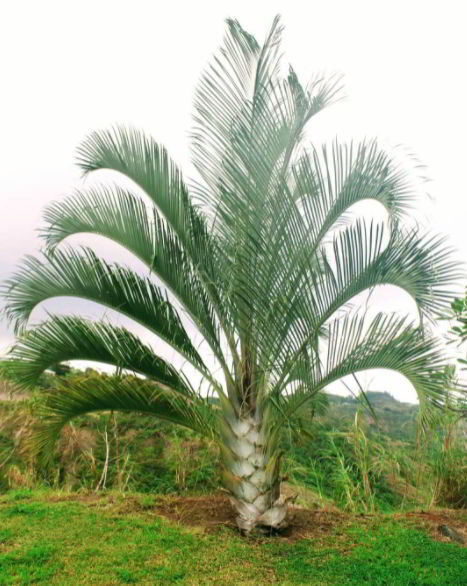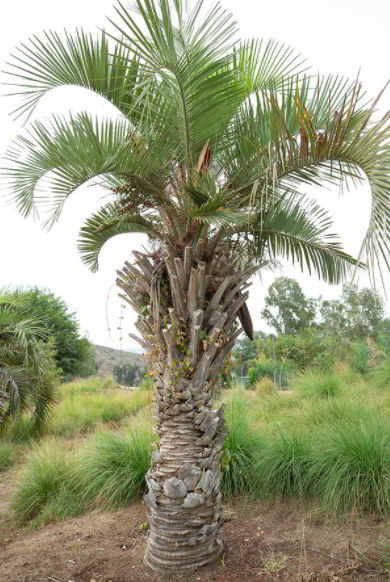Types of Palm Trees – Palms belong to the family of Arecaceae, which includes the monocotyledonous flowering plant. About more than 2600 types of palm were identified worldwide widely and were distributed in Asia and in America.
Many types of palms are grown in warm climates or tropical areas. However, some other types are tolerant of cold climates and can be found in the sub-tropical and temperate areas.
The classification of palms is generally based on their leaves and branchless steam. Each type of palm has a different characteristic, included its habitat, height, width, leaf, flower, fruit, and others.
Palm trees are among the tallest tree of plants in the world. Their appearance is unique, with an ornamental trunk.
The wood of palm trees has many benefits, such as being used for the construction of a house, furniture, and others.
Table of Contents
19 Popular Types of Palm Trees
Alexander palm (Archontophoenix alexandrae)

Alexander palm is native to the central and northern Queensland coastal rainforest of Australia and thrives in the areas of the wet tropics, which are about 1200 m of the sea level surface.
This type of palm requires a high water source and full of sunlight. Therefore it is described as an outdoor palm.
Alexander’s palm has bright green leaves and silver underneath of leaves, oval and bright on the ripe fruit, and purple and cream color on the flowers. The overall height of Alexander’s palm is about 40 to 80 feet.
Bismarck palm (Bismarckua nobilis)

The origin area of Bismarck’s palm is Madagascar. This type of palm is an outdoor palm that requires full of sunlight, survives in the minimum of water, and grows about 50 to 60 in height.
Bismarck’s palm has a silver-blue leaf, speckled brown flowers, and oval fruit, which is about 1, 5 inches with red color in ripe.
Read also:
Areca palm (Areca triandra)

Areca palm is originally found in India and Southeast Asia. It thrives in the place which partial shade to shade of sunlight and requires high water sources.
This type of palm has a dark green pinnate about 5 feet in length, oval fruit with orange-colored in ripe, and yellow-green flowers. The tree can reach around 10 t0 15 feet in height.
Canary Island date palm (Phoenix canariensis)

As its name suggests, this type of plan originally come from Canary Island. It has a spiny and medium green leaf, small white blooms on the branch, and oval with yellow to the orange of ripe fruits.
Canary island date palm commonly reaches about 40 to 60 in height and 20 to 40 in width.
Chinese fan palm (Livistona chinensis)

The name of the Chinese fan palm comes from its native areas, some islands of the South China Sea, and also can be found in Japan and Taiwan.
It thrives in tropical areas which full of sunlight and contains water. However, this type of palms is tolerant of drought. The height of the tree is around 20 to 35 feet and about 8 to 10 feet in width.
Chinese fan palm has a palmate leaf which is over 5 feet in length, a small light yellow flower, and an oval about ¾ inches in diameter with green color in ripe fruit.
Christmas palm (Veitchia merillii)

Christmas palm is native to the Philippines, Southeast Asia. It grows about 15 to 25 feet in height and width around 10 to 12 feet.
This type of palms thrives in the light shade area, which is abundant in waters. Christmas palm has a pinnate leaf, small green or grey flowers, bright red and oval on the ripe fruit, which is about 1,5 inches.
Chusan palm (Trachycarpus fortunei)

Chusan palm commonly thrives in the area were full or shade of sunlight. It originally comes from the Himalayas of northern India, northern Thailand, china, and also throughout the subtropical and temperate areas in the world.
The leaf is green palmate in medium size about 4 feet across, while its fruit is round bluish or purple in ripe.
Coconut palm (Coco Nucifera)

Coconut palm is the most common type of palm, which is considered native to of western pacific.
However, also can be found in tropical areas in the world. Nearly all parts of coconut palms use in many fields, such as beverages, food, furniture, and others.
Coconut palm is an outdoor palm that requires full of sunlight and is commonly found on beaches.
This type of palm has tall trees, reaches about 50 to 80 feet in height, pinnate leaf, round to oval green/ yellow of ripe fruit. The flesh of the fruit is white, which is soft and sweet.
Edible date palm (Phoenix dactilifera)

Edible date palm comes from North Africa. It has pinnate fronds with pale or green color, and its petioles are spiny.
The trunk is clustering which its diameter is about 16 inches, 400 to 100 feet in height, and has diamond patterns of its texture.
Its branches are 4 feet long, with small white blooms placed on them. The fruit is oval with orange color when ripe.
European fan palm (Chamaerops humilis)

This palm thrives in full to the shade of sunlight area. It is generally tolerant of drought.
European fan palm is originally found in the Atlas Mountains in Morocco, Spain, France, and eastward to turkey. The trunk is over 15 feet in height and clusters about 6 to 8 inches in diameter.
Its leave is palmate with medium green size, about 18 inches across. European fan palm has the small yellow blooms and oval orange to brown of ripe fruit.
Triangle palm (Dypsis decaryi)

Triangle palm is origin from south-eastern Madagascar. The leaves are pinnate fronds (about 8 to 12 feet in length) which are arranged around in one trunk.
This palm has round black fruit in ripe and yellow-green.
Fishtail palm (Caryota mitis)

Fishtail palm is mostly native to Andaman and Nicobar Islands, Burma, Malay peninsula, Minahasa Peninsula of the North Celebes, Java, and Sumatra.
The overall height of its trunk is 25 to 30 feet, while the leaf is bi-pinnate with medium green, which is similar to a fishtail. The shape of its leave become the reason for its name.
Foxtail palm (Wodyetia bifurcata)

Foxtail palm mostly thrives in the tropical area, which is full of sunlight and water. However, this type of palm is tolerant of drought.
The trunk is solitary which a diameter of about 8 to 10 inches, 25 to 30 feet in height, and has a smooth texture. Its leave is pinnate, about 10 feet in length with pale green color, and appears plumose.
Guadalupe palm (Phoenix rupicola)

As its name suggests, the name of this palm is adapted from its native area, the island of Guadalupe. The height of Guadalupe’s palm is 20 to 40 feet and requires full of sunlight.
It is commonly drought tolerant in mature. The leaf is costapalmate with light green color, while its flower is yellow on the branches and the ripe fruit is round black.
Majestic palm (Ravenea rivularis)

Majestic palm is found in Madagascar. Its leave is pinnate, about 18 feet long, with medium green color.
At the same time, the flowers are small white blooms on each branch.
It commonly requires a full or partial shade of sunlight areas which is a high source of water. Majestic palm reaches 40 to 60 in height.
Montgomery palm (Veitchia montgomeryana)

Montgomery’s palm has round bright red of ripe fruits which are on the branching inflorescences.
And its leave is pinnate, about 8 to 12 in length. It is originally found in Vanuatu of the southwest pacific. The height of this palm is about 80 to 100 feet.
Paurotis palm (Acoelorrhaphe wrightii)

This type of palm is native to Florida, Central America, the Caribbean, and the west indies. Paurotis palm inhabits in the area where full of sunlight and a high source of water, however it also can tolerant of drought.
The leave is palmate, about 2 to 3 feet across, which has different colors on each side, the green color above, and silver underneath.
Pygmy date palm (Phoenix roebeleni)

Pigmy date palm is originally found in the rainforest of Laos and Southeast Asia.
It requires full of sunlight and can survive in drought conditions. The leaf is pinnate, about 4 to 5 feet long, with bright green color, while its fruit is oval with purple color in ripe.
Pindo jelly palm (Syagrus romanzoffiana)

Pindo jelly palm has pinnate leave, about 6 to feet long with pale green or blue color, and small yellow to red blooms which shaped from the several lower leaves.
The overall height of this palm is 10 to 30 feet. The native areas of Pindo jelly palm are brazil, Uruguay, and Argentina.
Reference
- http://leafyplace.com/type-of-palm-trees/
- https://www.britannica.com/plant/palm-tree
 Natgeos Green and Vibrant
Natgeos Green and Vibrant


